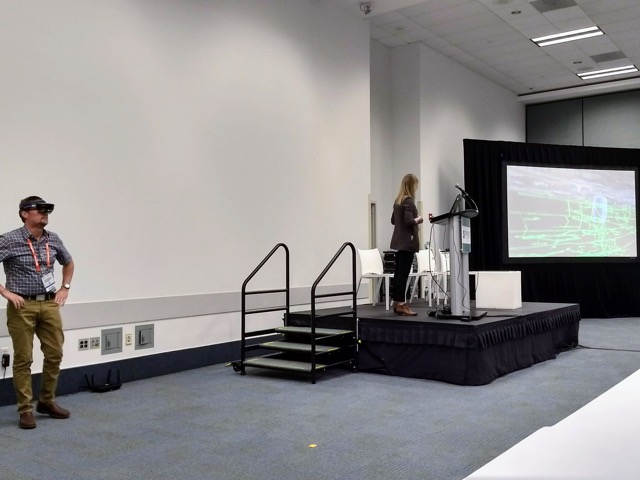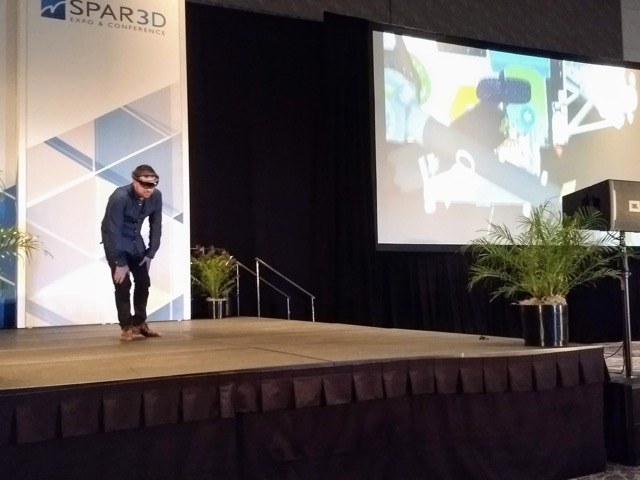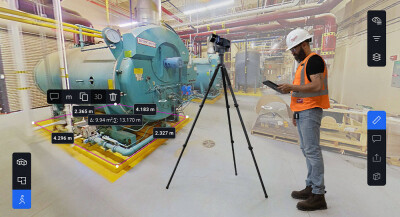This year’s SPAR 3D event probably had the most use of virtual reality headsets and domes—both on the conference stage and exhibition floor—that I have seen at any other geomatics- or 3D-imaging-related event. Not only did we witness the purposeful striding and physical gestures of a participant controlling their AR avatar on stage, it was also common to overhear conversations among fellow attendees about the types of gestures used in different AR/VR environments.
Viewing otherwise inaccessible environments
For the purposes of this blog, I will be using the terms AR/VR and mixed reality interchangeably. Before we start, we should also recap why a business invests in any type of new solution: It is to reduce cost, reduce risk, or realize a new opportunity that is ripe to be exploited. To different degrees, mixed reality environments fulfill each of these three investment criteria.
For one, they can permit the user to experience environments that might be unsafe or impossible to experience otherwise. In his keynote, NASA’s Alexander Menzies transported us to the surface of Mars. In an illustration of risk mitigation, he explored the design model of a rover vehicle destined for Mars. The rover includes a highly radioactive fuel component that engineers needed to practice installing before they did it for the first time—immediately before the rover was blasted into orbit.
In the Mining and Aggregates applications session, a presentation illustrated how inaccessible and gigantic engineering sites such as mines could be better explored by a range of project teams. Cassandra Koenig and Gerald Magnusson of BGC Engineering demonstrated how underground mining operations could be explored in holographic mixed reality via BGC’s Ada Platform. It was clear to see that bringing multiple 3D datasets together in one place does expose interactions and relationships, and provides potential for identifying opportunities (for example, new deposits for exploration or contamination hazards), as well as reduce the cost and risk that come with making poor decisions.

Gerald Magnusson of BGC Engineering explores an underground ore deposit, while Cassandra Koenig narrates what he sees
Will we see a new project line items for Augmented, Virtual or Mixed Reality technologies?
As with other technologies on the hype curve (drones anyone?) the number of organizations “playing” with AR/VR headsets and similar technologies has increased dramatically over the last year or so. The technologies are now available at consumer-level pricing, or given away with the latest cell phone—the accessibility of the tools coupled with the typical processing power in a regular office laptop means that these technologies are a low-risk write-off for many to experiment with. I was moderating the mining and aggregates session and approximately a quarter of the attendees in the room raised their hands to say they they were experimenting or using AR/VR in their place of work. Fortunately, we are seeing structured professional solutions appear that are geared towards specific application environments, such as with the BGC example above.
Now, while I am pleased to see the business cases emerging for using AR/VR, I must admit that I am still a little skeptical if headsets and domes are giving us benefits that can justify their own line-item on a project budget sheet, in all contexts.
The case for training—such as the installation of the radioactive material on the Mars rover—has always sat well with me, especially if the haptic and tactile extensions are used in the virtual environment that enable the user to practice “doing” as opposed to just studying.
Using AR/VR technology to display information for project collaboration and pure visualization of datasets is where I am finding it difficult to justify the AR/VR business case. Firstly, engineers and industry professionals should already be accustomed to interrogating both traditional 2D diagrams and the 3D visualizations that we see on computer screens. Personally, I am still to be convinced about how being able to virtually walk around a 3D rendering of a mine site provides additional information to viewing the same information on a regular screen.
As we look to develop the 3D visualization business case further, maybe instead of focusing on the type of headset to look at the data in question, perhaps we can look at additional ways in which the design drawings can be taken out of the context of the engineer’s desktop and exposed to a wider audience? Perhaps we can look to widen the mediums of information displayed in project management software?
If all we are doing is looking at an environment or visualizing data, why do we need to walk around it? Surely the value of AR/VR is when we can actually “do” something in that environment? Or do I carry too many assumptions that our existing means for visualizing 3D information are sufficient?
3D-imaging sensors and platforms continue to provide us as opportunities to collect, catalogue and analyze an ever-expanding range of information about our environment that may not have been possible before, so I want any type of new visualization technology to succeed. What I would like to see, however, are more examples of where the use of an AR/VR environment is absolutely critical to undertaking specific business operations and activities—and not just a different way of visualizing information, especially if it means eliminating risk in the working environment.








.jpg.small.400x400.jpg)

